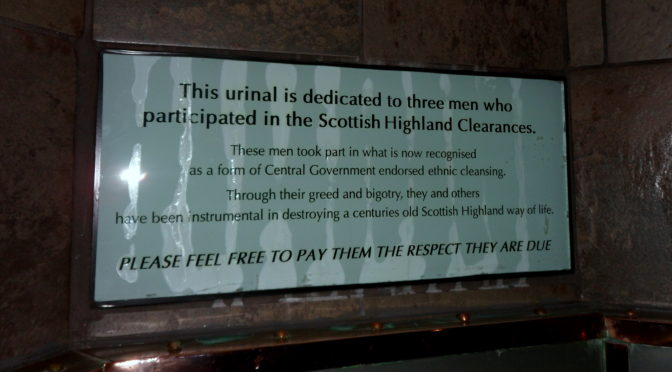About America could learn from Mannie
At the summit of Ben Bhraggie, overlooking the village of Golspie in Sutherland, stands a massive memorial to the 1st Duke of Sutherland, George Leveson-Gower. The 100ft statue, dubbed ‘The Mannie’, was built after money to build it was raised by public subscription.
The Duke is a figure of hatred in the Highlands. He was the man most closely associated with the Highland Clearances, arguably the worst example of what can only be called domestic terrorism perpetrated by the landed gentry against Scotland’s rural population. Thousands were burned out of their homes and sent away in boats to Canada and the US never to see their homeland again. The land they once occupied was turned over to sheep. They were more profitable than humans.
Over the years the statue has been defaced, and there have been attempts to have it removed. So far, they haven’t succeeded. The belief among Scots seems to be that, while this was a hellish part of our history, it happened and it should never be forgotten. The Duke’s statue stands as a painful reminder of our past.
There was a report last week that parcels of the land are to be sold off to the descendants of the people who were cleared. It’s a very sensible, adult way of behaving. Compare it with the lunacy on this side of the Atlantic, where America has become convulsed by SRH (Statue Removal Hysteria).
The past two weeks have been horrible here. I was born 11 years after World War Two ended, and I never thought I’d see people – in my adopted home – marching through the streets carrying Nazi flags, wearing Swastika armbands, and gathering outside a synagogue chanting Sieg Heil. It’s chilling, to say the least.
There are obviously dark forces at work in America right now, and the planned removal of statues of Confederate ‘heroes’ like Robert E Lee and ‘Stonewall’ Jackson have brought them out in force. Obviously, Lee, Jackson, Jefferson Davis and other Confederate Civil War leaders represented a chapter that right-thinking people in America find repugnant.
Of course, it isn’t just the memory of slavery that is the problem here, it’s that racism is so built into the American psyche. The economy of America’s southern states was once built on slavery, and there are many today who still believe that non-white people are inferior in every way.
But the people who invaded Charlottesville do not speak for America. Steve Bannon got it right when he referred to the alt-right brigade who showed up there as ‘a collection of clowns’. And he is one of their greatest cheerleaders.
If we put to one side the actions of the mob, and the gibberish that emanates from the President, it pays to listen to more reasonable, and interesting, voices.
Many thousands of southerners, proud of the Confederate past, have come out of the woodwork to say they are horrified by what is happening. One man, draped from head to toe in Confederate clothing, spoke of his pride at what his ancestors had fought for during the Civil War, but made the point that his grandparents had fought equally hard to defeat the Nazis.
The bottom line is that, unlike Scotland, America doesn’t seem able to have a grown-up conversation about its troubled past. Everything here seems to be – if you’ll pardon the expression – black or white. There is no middle ground, you are either for us or against us.
Just as the Clearances happened, so did the Civil War. It may have been one of the bloodiest and stupidest wars in history, but it happened nonetheless. Many of these statues were put up for all the wrong reasons, to goad people during the Civil Rights era, but tearing them down won’t erase the war. Moving them to a museum or somewhere more appropriate than a town square might be more sensible, but common sense hasn’t entered the debate so far.
Fort Bragg, the huge US military installation in North Carolina, is named after a Confederate general. What about Jefferson Davis County in Mississippi? There are hundreds of other examples. Should all these places be renamed?
Buchanan Street and Glassford Street in Glasgow were named for Tobacco Lords who made their fortunes on the back of slave labour in America. There’s Virginia Street and Jamaica Street? As a Scotsman report in 2007 put it, “These streets crisscross modern day Glasgow like scars from a slave-master’s lash.”
Believe me, Scotland looks like a haven of sanity right now compared with the USA. It baffles me that a nation with so much influence in the world, home to so many intelligent individuals, is unable to move forward and let go of its 18th century baggage.
Perhaps an American delegation should take a trip to the Lios Mor bar in the west end of Glasgow and see how Scots deal with things. The gents’ toilet has three urinals, each emblazoned with the names of villains of the Highland Clearances – Patrick Sellar, George Granville, and Colonel Fell.

A plaque on the wall reads, “This urinal is dedicated to the three men who participated in the Scottish Highland Clearances.
These men took part in what is now recognised as a form of central government endorsed ethnic cleansing.
Through their greed and bigotry, they and others have been instrumental in destroying a centuries old Scottish Highlands way of life.
PLEASE FEEL FREE TO PAY THEM THE RESPECT THEY ARE DUE.”
Now if Americans could only pee on their old foes…how much better would they feel?
